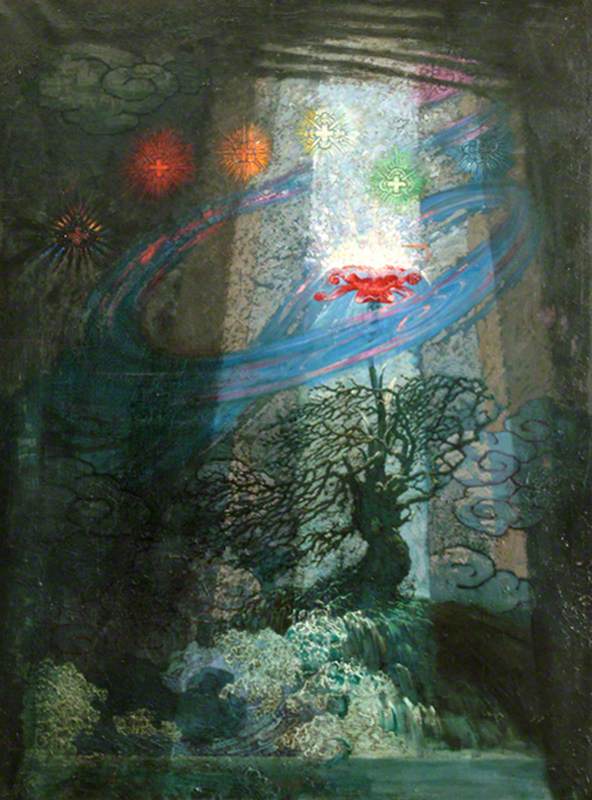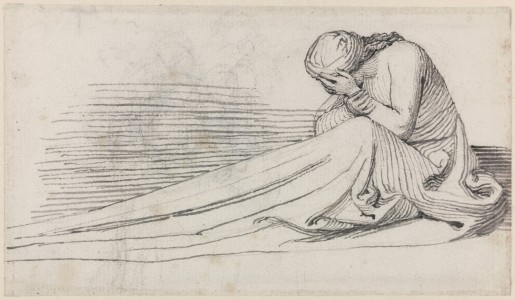John Flaxman was internationally the most famous British sculptor before Henry Moore. However, his fame abroad was due not to his sculpture but to his engraved outline illustrations of Homer, Aeschylus and Dante, first published 1793–1795. This is why a German visitor to the artist's studio during his lifetime had no idea of his career as a sculptor (i), despite the fact that his monuments, often on a large scale, were to be seen in St Paul's Cathedral, Westminster Abbey and a great many other churches throughout Britain.
Much has been written on Flaxman's sculpture and on his drawings, but invariably they have been dealt with separately, so there is little discussion as to how far his drawings are those of a sculptor, or his sculpture that of an artist deeply concerned with drawing. The presence of schematic drawings among those left in his workshop, now in the collection of UCL Art Museum, also raises the question of whether he had a systematic theory of drawing. This leads to a consideration of Flaxman's lectures to the Royal Academy, where he was the first Professor of Sculpture from 1810 until his death in 1826. The lectures have rarely been written about in relation to his own work, though British artist and writer Deanna Petherbridge has brought them into a discussion of his drawing methods (ii).
Flaxman used drawing for a number of different purposes. There are drawings in UCL's Flaxman Collection connected with sculpture, some of which, like the drawing of Resignation (UCL Art Museum 713) may be a preliminary study for more than one monument (iii).
Other more finished drawings, like the three of the Mansfield Monument in Westminster Abbey (UCL Art Museum 708, 709r, 710 – seen at the top of this article) and the drawing for the Lyon monument, Group of Three Cloaked Figures (1787–1794) in Harrow (UCL Art Museum 714), may have been made to demonstrate to patrons how the monument would fit in the church setting.
The drawing of Feed the Hungry (UCL Art Museum 698), is a finished work, part of a series of The Acts of Mercy, which were published as aquatints after his death (iv), while a drawing of a medieval sculpture represents the great many drawings the sculptor made in Italy and elsewhere of earlier works of art.
The studies from living figures can be divided broadly into two types. There are the drawings, for example, of a woman distributing alms to a group of poor people outside her door (UCL Art Museum 716) and another of three cloaked figures in conversation (UCL Art Museum 824) that are clearly based on observations of Roman street life, and which were later used in compositions, the former for The Acts of Mercy and the Yarborough monument of 1806 (UCL Art Museum 1093), and the latter for the outlines to Dante. But one of the largest categories of drawings is that of simplified studies of human actions and drapery, concerned with the essential movements of the body.
At the heart of Flaxman's concerns as both draftsman and sculptor is the ideal human figure. He has no interest in landscape and only rarely made portraits; his representations of the human figure are not of individuals but of types. This was entirely conventional in the late-eighteenth and nineteenth centuries, and his role as Professor of Sculpture at the Royal Academy confirms that he was at the centre of academic practice and teaching. His commitment to the representation of the human body was directly connected to his deep admiration for Greek sculpture, as it was known from the canonical sculptures (mostly Roman copies of Greek originals, though that was not always recognised at the time) visible to students in Rome, where he studied from 1787–1794. In his lectures to the Royal Academy (1810) he cites Socrates who advocated 'the study of the human form; because the human form is the most perfect of all forms, and contains in it the principles and powers of all inferior forms' (v).
The drawings which focus on human figures and drapery seem to exist quite apart from his sculpture and from the many studies made from Roman street scenes. Everything is reduced to an absolute minimum of lines without shading or depth of focus. They are too deliberately stylised to have been drawn directly from people observed in the street. They clearly fit with remarks made by Flaxman in his lectures to the Royal Academy and in some cases directly relate to illustrations in his lectures, which were published after his death, in 1829 and 1838. Some seem to form the workings for a fully illustrated treatise on drawing and sculpture that Flaxman may have worked on in the years after he returned to London from Italy in 1794. The lectures to the Royal Academy contain what appears to have been a distillation from the unrealised treatise: specifically Lecture IV, On Science; Lecture V, Beauty; Lecture VI, Composition; Lecture VII, Style; and Lecture VIII, Drapery. These lectures stand apart from the rest of the lectures, which are otherwise largely historical.
Though Flaxman claims that 'sentiment is the life and soul of fine art!' he also argues for the artist to know arithmetic, by which he means knowledge of the proportions of the human body, and geometry, which he defines as 'lines and diagrams for the motion, outline, and drapery of the figure, regulated by the harmony of agreeable proportions, or the opposition of contrast'. He does not see arithmetic and geometry as being opposed to or in tension with sentiment but as necessary components of all sculpture, though it is clear that he associates the former with pagan Greece and the latter with Christianity. As a fervent Christian, however, he clearly saw the Greeks as masters of the means and Christianity as suited to the ends of art. But these means and ends were intimately connected because 'every passion, sentiment, virtue, or vice, have their corresponding signs in the face, body, and limbs' (vi).
Deanna Petherbridge raises two further questions about Flaxman's systematic drawings. The first is whether the forms of a represented human figure necessarily relate to basic mathematical forms. Flaxman cites the Professor of Painting at the Royal Academy, Henry Fuseli, as an authority for the proposition that 'the (general) forms (of masses in composition) are the pyramid erect, inverted or lateral, the circle and the oval'. This he then connects to expression, so that 'the parts will be more simple and rectilinear in repose, more angular in violent action, and partaking of gentle curves when the subject is tender, and the person elegant'. Yet he also argues that such considerations should not be applied mechanically, 'but partake of the wonderful variety of nature, in which all faces, all bodies, and all efforts are different' (vii).
The second question is: can particular kinds of line contain meaning in themselves; becoming, as it were, a type of hieroglyph? Flaxman uses a musical analogy to suggest that lines might at least have inherent properties in relation to each other, so that 'two equal curves, set with either their convex or concave faces to each other, produce opposition (e.g. ‘)( ()’); but unite two curves of different size and segment, they will produce that harmonious line, termed graceful, in the human figure (S)'. There was, however, in Flaxman's time a theory associated with someone he knew in Rome, the Dutch artist Pierre David Giottino Humbert de Superville, that lines (and colours) could constitute signs in themselves that conveyed certain emotions universally (viii). Thus a vertical line corresponds to the axis of an upright man turned towards heaven, a horizontal line, which corresponds to the horizon is associated with serenity and equilibrium, while oblique lines can in one direction indicate a positive desire for life, and in the other direction be lugubrious and solemn. These directions apply to everything, the most obvious one being the contemporary 'emoticon', which can with eyebrows and mouth upturned denote happiness, and down turned denote the opposite. But because these characteristics of line are supposedly universal they can, according to Humbert de Superville, be applied to animal as well as human heads, to trees and to architecture, so that a classical frieze can denote stability, and a Gothic arch be implicitly pious in its direction towards heaven.
Flaxman would probably have resisted taking such a theory to the point of abstraction, but he was clearly sensitive to the use of curves and their direction: the upward movement of angels carrying a soul to heaven and the downward and graceful curve of a grieving female body, and the distribution of weight in a body that would drag it down or raise it up. But his studies of the changing centre of gravity of bodies suggest an unwillingness to see lines as wholly detachable from the human form in movement, with all its individuality and capacity for expressing feeling.
David Bindman, Emeritus Professor of the History of Art, University College London
This text has been adapted from a piece written for the catalogue of the 2013 Flaxman exhibition at the IKON gallery in Birmingham.
(i) Ludwig Schorn in David Bindman ed., John Flaxman, exhibition catalogue, Royal Academy, Thames and Hudson, 1979, p.30
(ii) Deanna Petherbridge, The Primacy of Drawing: histories and theories of practice, Yale University Press, 2010
(iii) For a discussion of Flaxman's use of repetition of designs for monuments see David Bindman ed., John Flaxman, op. cit., p.29
(iv) John Flaxman, eng. Foe. Lewis, The Acts of Mercy, 1831
(v) John Flaxman, Lectures on Sculpture, John Murray, 1829, p.102
(vi) Ibid., p.141
(vii) Ibid., p.173
(viii) Deanna Petherbridge, The Primacy of Drawing, op. cit., pp.200–202, and David Pierre Giottino Humbert de Superville, Essay on the Unconditional Signs in Art (Essai sur les signes inconditionnels dans I'art), 1827, in Jacob Bolten ed., Miscellanea: Humbert de Superville, 1997, pp.27–125















.jpg)












